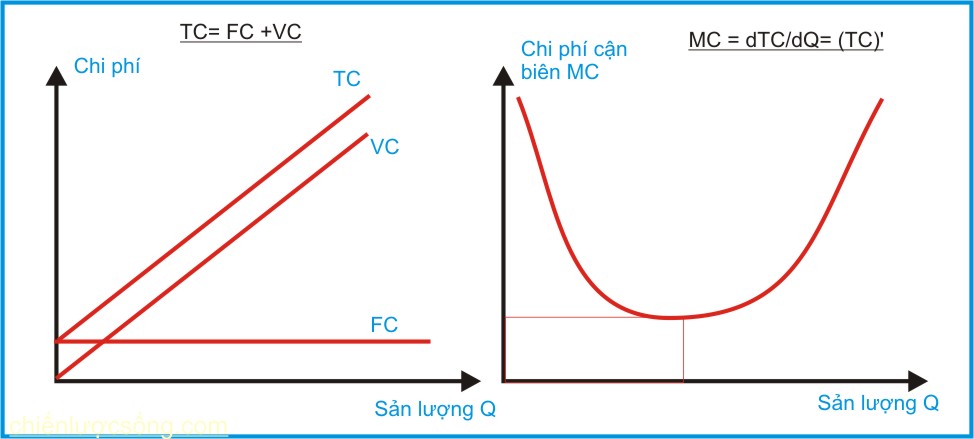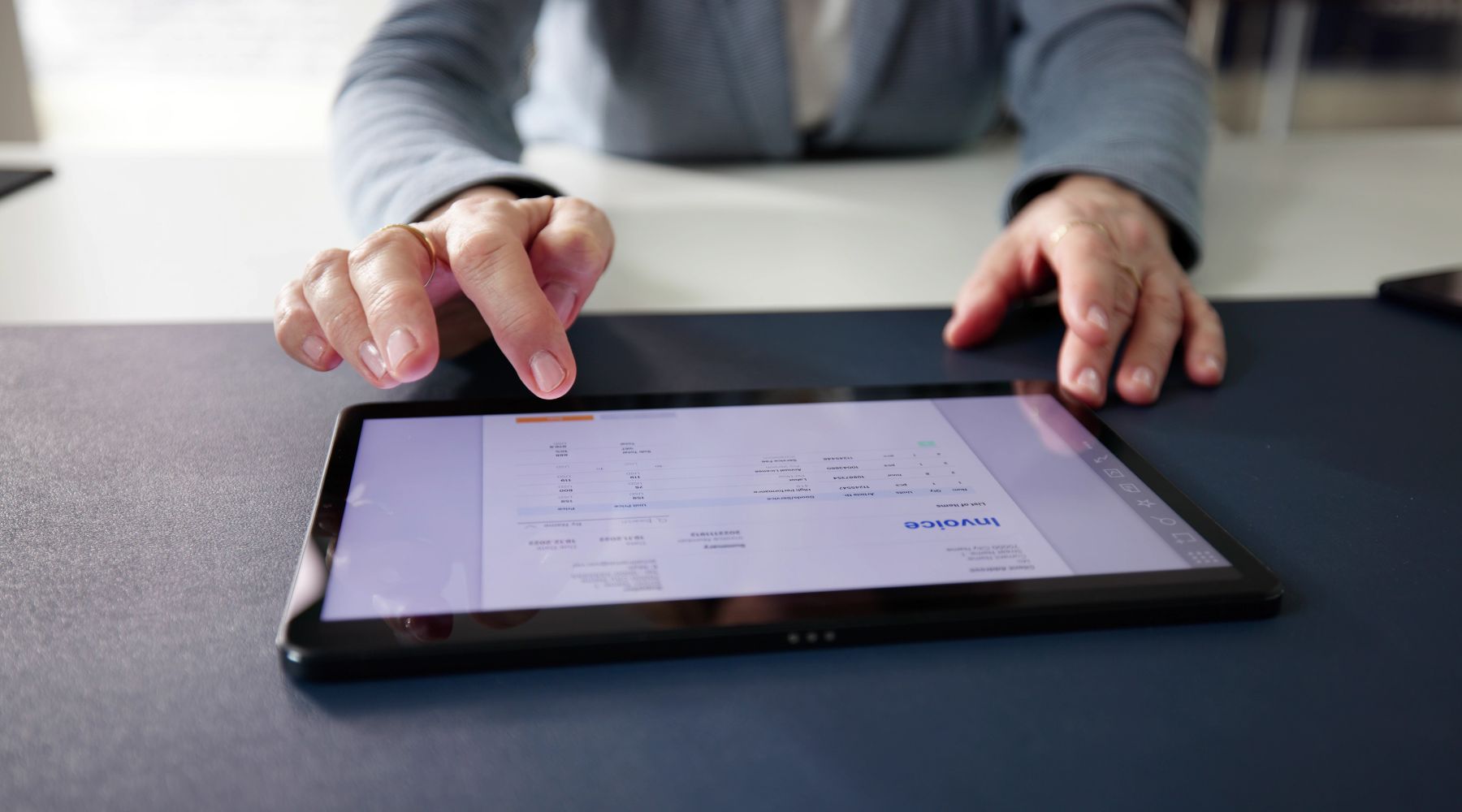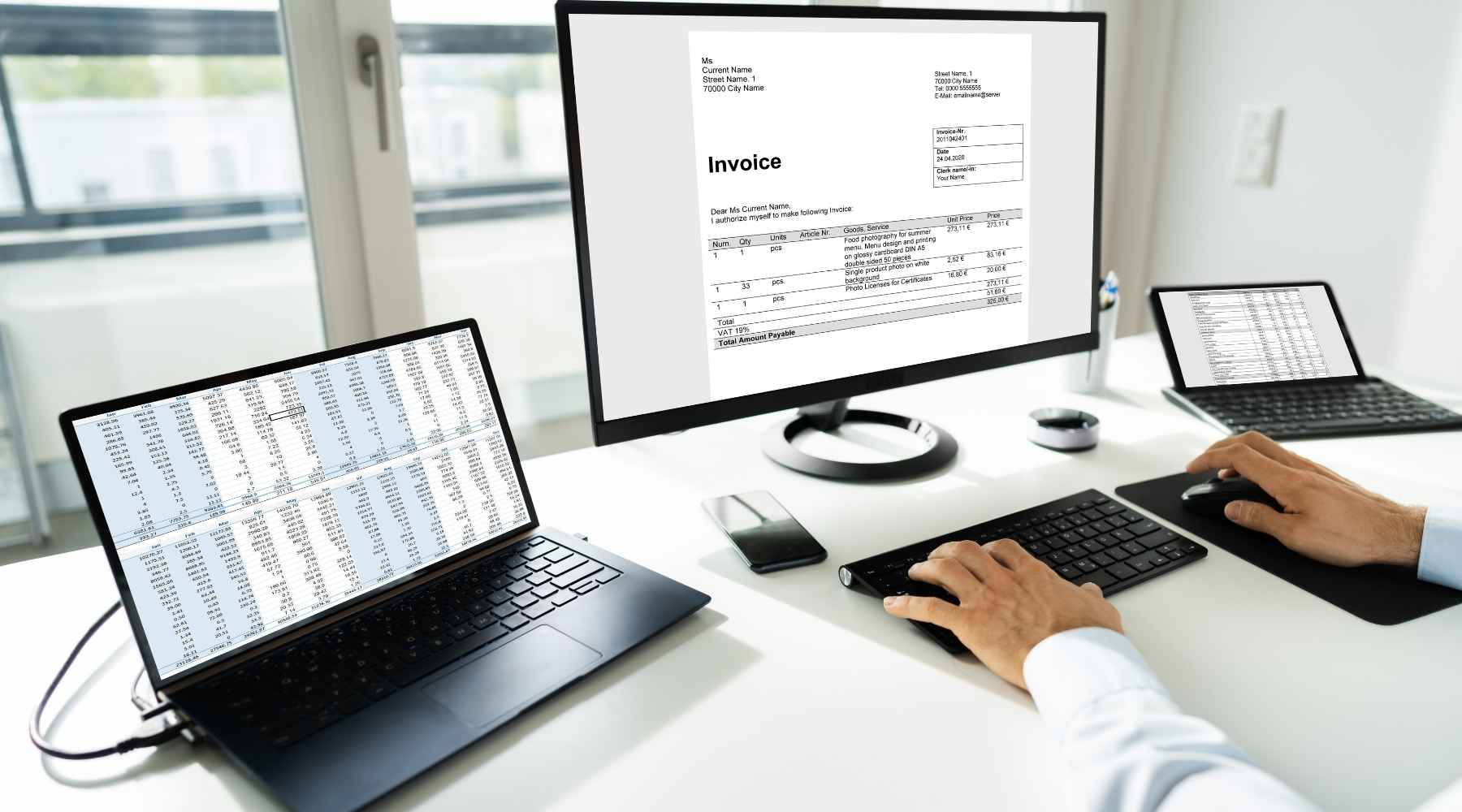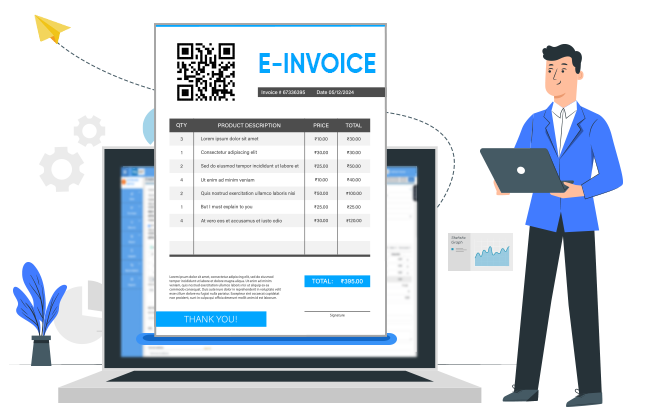Chi phí cận biên là chỉ số quan trọng giúp doanh nghiệp tối ưu hóa sản xuất. Việc kiểm soát và giảm chi phí cận biên sẽ giúp tăng lợi nhuận, cải thiện hiệu suất và cạnh tranh tốt hơn trên thị trường.
Trong bài viết này, Bizzi sẽ cung cấp cho bạn đầy đủ thông tin liên quan đến chi phí cận biên là gì cũng như cách tối ưu chi phí để tối đa hóa lợi nhuận.
Định nghĩa và đặc điểm chi phí cận biên là gì?
Define
Chi phí cận biên (Marginal Cost – MC) To be chi phí phát sinh thêm khi sản xuất thêm một đơn vị sản phẩm hoặc dịch vụ. Đây là mức chi phí tăng thêm (∆C) để tạo ra một đơn vị sản lượng mới (∆Q). Chi phí cận biên giúp doanh nghiệp hiểu sự biến động của tổng chi phí khi sản xuất thêm sản phẩm và hỗ trợ trong việc cost management and ra quyết định sản xuất.
Marginal cost characteristics
Measure only additional costs
- Chi phí cận biên đo lường chi phí tăng thêm (mức độ chi phí mới) khi sản xuất thêm một đơn vị sản phẩm.
- Không tính các chi phí cố định or chi phí không thay đổi (Chi phí cận biên không đổi) trong sản xuất.
Giúp doanh nghiệp tập trung vào chi phí bổ sung
- Chi phí cận biên hỗ trợ doanh nghiệp tập trung vào các chi phí bổ sung thay vì toàn bộ chi phí sản xuất trong doanh nghiệp, giúp tối ưu hóa quy trình sản xuất và giảm thiểu lãng phí.
Depends on production scale
Chi phí cận biên thay đổi khi quy mô sản xuất thay đổi:
- Economies of Scale (Tiết kiệm nhờ quy mô): Chi phí cận biên có thể giảm khi sản lượng tăng, nhờ việc tận dụng hiệu quả nguồn lực như nhân lực và máy móc.
- Diseconomies of Scale (Bất lợi quy mô): Khi sản xuất vượt quá mức tối ưu, chi phí cận biên có thể tăng lên do hạn chế tài nguyên (máy móc, nhân lực, nguyên liệu).
May change over time
- Ngắn hạn: Chi phí cận biên có thể biến động mạnh vì các yếu tố như nguyên liệu, nhân công, and năng suất máy móc có sự thay đổi theo thời gian.
- Dài hạn: Doanh nghiệp có thể giảm chi phí cận biên thông qua các chiến lược đầu tư công nghệ, tối ưu hóa quy trình sản xuất, and quản lý tài nguyên hiệu quả.
Marginal cost formula
Để đi sâu hơn về khái niệm chi phí cận biên là gì, dưới đây là công thức tính chính xác:
– General formula: MC = ∆C / ∆Q.
- In there:
- MC: Marginal Cost.
- ∆C (Change in cost): The change in total cost is calculated by subtracting the total cost of production from the old output from the new output.
- ∆Q (Change in output): Change in total quantity of products,is calculated by new total output minus original total output.
– Lưu ý: Công thức này chỉ tính toán additional cost per unit of product, not counting the total cost of the entire production.
For example:
- A lipstick factory has a total cost of 100 million VND for 1,000 lipsticks.
- If 100 more lipsticks are produced, the total cost increases to 105 million VND.
- Marginal cost = (105 million – 100 million) / (1,100 – 1,000) = 50,000 VND/lipstick.
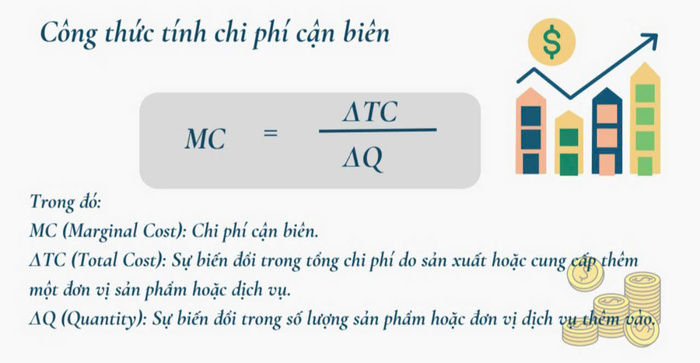
Meaning and role of marginal cost
Chi phí cận biên (Marginal Cost – MC) đóng vai trò quan trọng trong nhiều khía cạnh của doanh nghiệp, từ quản lý sản xuất, định giá, chiến lược cạnh tranh đến hoạt động phân tích quyết định tài chính.
Below are the important meanings and roles of MC in each area of the business:
– In business management:
- Helps optimize production levels, thereby maximizing profits.
- Support making correct and optimal management decisions for pricing and business strategies.
- Helps managers compare results during plan implementation.
- Plays a role in assessing the quantity of goods and services provided to consumers.
- Support revenue comparison and make decisions to cut ineffective activities.
– Compare with Marginal Revenue (MR):
- If MR > MC: Profit is likely to increase, so increase output.
- If MR ≤ MC: Need to improve revenue and cost management, even stop production because it may be losing money.
– In Production:
- Helps determine optimal output levels for maximum profit.
- Ảnh hưởng đến giá cả, hỗ trợ điều chỉnh giá phù hợp và đánh giá hiệu quả dây chuyền sản xuất, giảm thiểu rủi ro và tránh lỗ vốn.
– In Marketing:
- Is the foundation for determining the next marketing steps.
- If the marginal cost of increasing advertising spending is less than the additional revenue, increasing advertising spending is rational.
- Helps determine optimal pricing to maximize revenue.
– In Finance:
- Help investors evaluate the feasibility of the project and the profits it brings.
- Help managers develop policies to minimize risks and avoid financial losses if costs get out of control.
Relationship between Marginal Cost and Average Cost
Average Cost (AC) is the cost per unit of output, calculated by dividing total cost by the number of products.
Mối quan hệ giữa Chi phí cận biên (MC – Marginal Cost) và Chi phí bình quân (AC – Average Cost) là một trong những nguyên lý quan trọng trong kinh tế học vi mô, đặc biệt trong lý thuyết về chi phí sản xuất. Mối quan hệ này có thể được mô tả như sau:
- As output increases, if MC < AC then AC will decrease.
When marginal cost is less than average cost, each additional unit of output costs less than average, causing average cost to fall. This is the stage where the firm is taking advantage of economies of scale.
- As output increases, if MC > AC then AC will increase.

When marginal cost is greater than average cost, each additional unit of output costs more than the average, causing average cost to rise. This is the stage where diseconomies of scale appear.
- When MC = AC then AC is at minimum.
When MC = AC, average cost reaches its minimum. This is the point at which the firm is most cost efficient. At this point, if the firm produces less, average cost will still fall; if it produces more, average cost will begin to rise.
Marginal cost (MC) helps compare the results of implementing the plan, while average cost (AC) is used to evaluate the impact of changes in output on unit costs. This helps the business determine the optimal output level to minimize production costs.
The basic difference between these two types of costs is: MC is a cost increase per unit, AC is the cost on each unit.
Marginal cost curve
- For a typical business, it usually takes the form of an inverted parabola or a U-shape.
- Initially: MC value tends to decrease because costs (fixed + variable) per unit tend to decrease (economies of scale).
- Giai đoạn sau: Đến giữa chu kỳ, chi phí biến đổi liên tục tăng lên, cao hơn tốc độ giảm của chi phí cố định, khiến MC bắt đầu tăng lên.
- Điểm đảo chiều: Là điểm mà tại đó, mức tăng của chi phí biến đổi bằng mức giảm của chi phí cố định.
- When output is low, MC can be high due to excess production capacity.
- As output increases to the optimal level, MC reaches a minimum value, then increases again if output exceeds the optimal level.

Notes when analyzing marginal costs
- Difficult to apply in some industries: Như đóng tàu, máy bay,… với sản phẩm dở dang có giá trị lớn tương ứng doanh thu. Việc không tính chi phí cố định vào giá trị cuối kỳ sản phẩm dở dang có thể gây sai lệch.
- Don't ignore exogenous factors and hidden costs: Raw material costs can change according to the market, labor costs can fluctuate due to wage increases or government policies, opportunity costs (can create higher profits if resources are used for other purposes).
- Pay attention to economies of scale: As production expands, marginal costs can decrease due to economies of scale (reduce average cost). However, if it exceeds the optimal level, marginal costs may increase due to the phenomenon of economies of scale.
- Caution should be exercised when applying: Must be presented and explained reasonably, accurately, and in relation to all variables in the particular situation.
- Identify variable costs clearly: To calculate accurately, it is necessary to determine which components of the total cost have variations and the specific amount of variation.
- Distinguish and understand the nature of marginal cost and average cost
- Determine calculation time and external factors: Costs can change over the short and long term, influenced by markets, technology, and policies.
- Avoid confusion with average cost.
How to reduce marginal costs effectively
– Leveraging economies of scale
- When producing in large quantities, marginal costs tend to decrease due to better utilization of resources.
- Solution: Increase production when marginal cost is lower than selling price to maximize profit.
– Reduce raw material and production costs
- Negotiate with suppliers to buy raw materials in bulk at better prices.
- Improve production processes to save materials and time.
– Technology application & automation
- Áp dụng máy móc, phần mềm ERP để giảm chi phí lao động và tăng hiệu suất.
- Technology helps reduce errors, avoid waste and improve productivity.
– Optimize human resources and work processes
- Train employees to improve performance and reduce errors in production.
- Arrange work properly to avoid wasting labor.
– Good control of fixed and variable costs
- Reduce fixed costs by optimizing rental space and warehouses.
- Consider outsourcing some services instead of doing them yourself if it's cheaper.
- Find suppliers with reasonable prices
– Leverage data to forecast demand
- Use data analysis to produce exactly what the market needs, avoiding overproduction and waste.
Evaluate a business based on marginal cost
Chi phí cận biên (MC) cung cấp thông tin quan trọng về hiệu quả hoạt động, khả năng cạnh tranh, và sự bền vững của doanh nghiệp trong dài hạn. Cụ thể hơn, sự tác động của chi phí cận biên là gì mà dựa vào đó, doanh nghiệp sẽ nắm được tình hình tài chính?
Dưới đây là các tác động của chi phí cận biên lên doanh thu:
– Production efficiency
- If MC decreases as output increases → The firm is taking advantage of economies of scale, more efficient production.
- If MC increases rapidly when expanding production → The business may encounter economies of scale or the cost of raw materials and labor increased sharply.
– Khả năng định giá và lợi nhuận của chi phí cận biên là gì?
- If MC lower than selling price, businesses can continue production to maximize profits.
- If MC close to or above the selling price, profit margins fall, signaling that the business may be in financial trouble.
– Competitive strength
- Businesses have MC is lower than the opponent maybe sale price while still maintaining profits, creating competitive advantages in the market.
- Conversely, if MC is higher, the firm may experience price pressure and lose market share.
– Khả năng mở rộng kinh doanh dựa vào chi phí cận biên theo sản lượng
- If MC slow increase in output, businesses are able to scale without incurring too much cost.
- If MC increase rapidly, expansion may be unsustainable or require technology investments to reduce costs.
– Financial risk
- If MC is consistently higher than selling price → The business may be selling at a loss, and needs to re-evaluate pricing strategy and optimize costs.
- If MC fluctuates strongly → Raw material or labor costs may be unstable, affecting long-term financial planning.
In short, it is possible to evaluate a business based on MC, but it needs to be combined with other indicators such as:
- Gross profit & net profit → See if the business is making a profit.
- Profit Margin → Assess profitability.
- Fixed costs & variable costs → Understand the cost structure.
- Brand strength & market share → MC is low but without a strong brand, it is still difficult for a business to succeed.
Conclude
Bài viết sau đã giải đáp cho câu hỏi chi phí cận biên là gì cùng những gợi ý liên quan đến việc cost management hiệu quả. Chi phí cận biên là một khái niệm quan trọng trong kinh doanh và tài chính, giúp doanh nghiệp đưa ra các quyết định sản xuất, định giá và quản lý chi phí hiệu quả. Việc nắm vững khái niệm, công thức tính và ý nghĩa của chi phí cận biên là gì sẽ giúp xây dựng kế hoạch kinh doanh hoặc đầu tư phù hợp.
At the same time, businesses need to be careful when applying and analyzing marginal costs in specific situations; other factors need to be considered to make accurate decisions.

Expense management software is increasingly being adopted by businesses, especially in the e-commerce and shipping services sectors, to improve operational efficiency through process automation and effective budget management. Bizzi is one of the leading cost management software solutions, trusted by large enterprises such as Masan Group, Mondelez International, Pierre Fabre,... thanks to its superior automation power and integration capabilities.
Không chỉ đơn thuần hỗ trợ doanh nghiệp quản lý chi phí, Bizzi còn giúp tối ưu nguồn lực và tăng cường hiệu quả thông qua các tính năng đột phá như tự động điều hướng luồng duyệt theo đơn vị, quy chế, phân quyền đã thiết lập; phân tích chi phí và báo cáo tài chính theo thời gian thực; quét dữ liệu và kiểm tra tính hợp lệ của Electronic invoice,…
With a user-friendly interface design, Bizzi Expense is the ideal solution for businesses that want to improve cost management, modernize processes and aim for sustainable development and long-term competitiveness.
- Link to register for a trial of Bizzi products: https://bizzi.vn/dang-ky-dung-thu/
- Schedule a demo: https://bizzi.vn/dat-lich-demo/
Đọc thêm:

